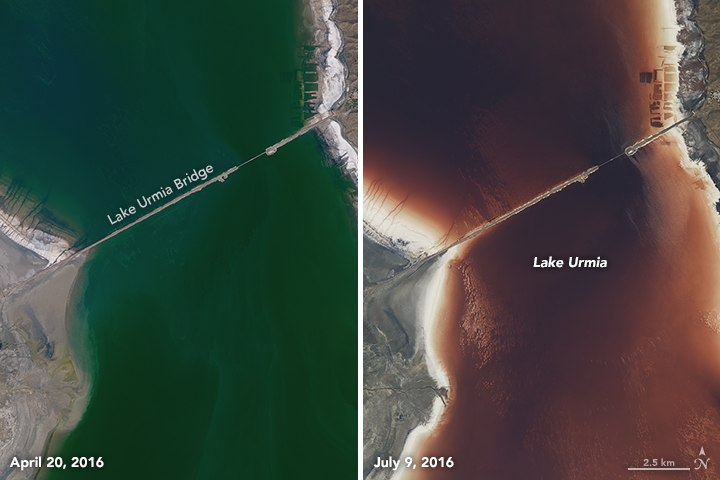Iran’s salty Lake Urmia has shrunk rapidly during the past few decades, making it saltier.
And as it grows saltier, microscopic organisms are periodically turning the water striking shades of red and orange. Or is it something else?

These satellite pictures captured by Modis show a sharp transition in the color of Lake Urmia between April and July 2016. On April 23, the water was green; by July 18, it was blood red.

Scientists explain this seasonal color change with precipitation and climate patterns: “Spring is the wettest season in northwestern Iran, with rainfall usually peaking in April. The combination of rain and snowmelt sends a surge of fresh water into Lake Urmia in April and May. By July, the influx of fresh water has tapered off and lake levels begin to drop. In turn, the salinity of the water increases.” And that’s when the microorganisms show their colors, too.
While Lake Urmia has shifted from green to red and back several times in recent years, trends suggest that a red Urmia could become increasingly common.
As written by the uploader of the next Youtube video: “This lake is crying… Just see how the water has changed to red… The main reason is Iran’s dams and the idiot way of bridge construction on the lake.”
Drought and intensive water diversion for agriculture has been limiting the amount of fresh water reaching the lake. The lake volume has been decreasing at an alarming rate. The results from satellite imagery reveals a loss of water extent at an average rate of 220 square kilometers per year, which indicates that the lake has lost about 70 percent of its surface area over the last 14 years.












[…] These satellite pictures captured by Modis show a sharp transition in the color of Lake Urmia between April and July 2016. On April 23, the water was green; by July 18, it was blood red….. [read more] […]